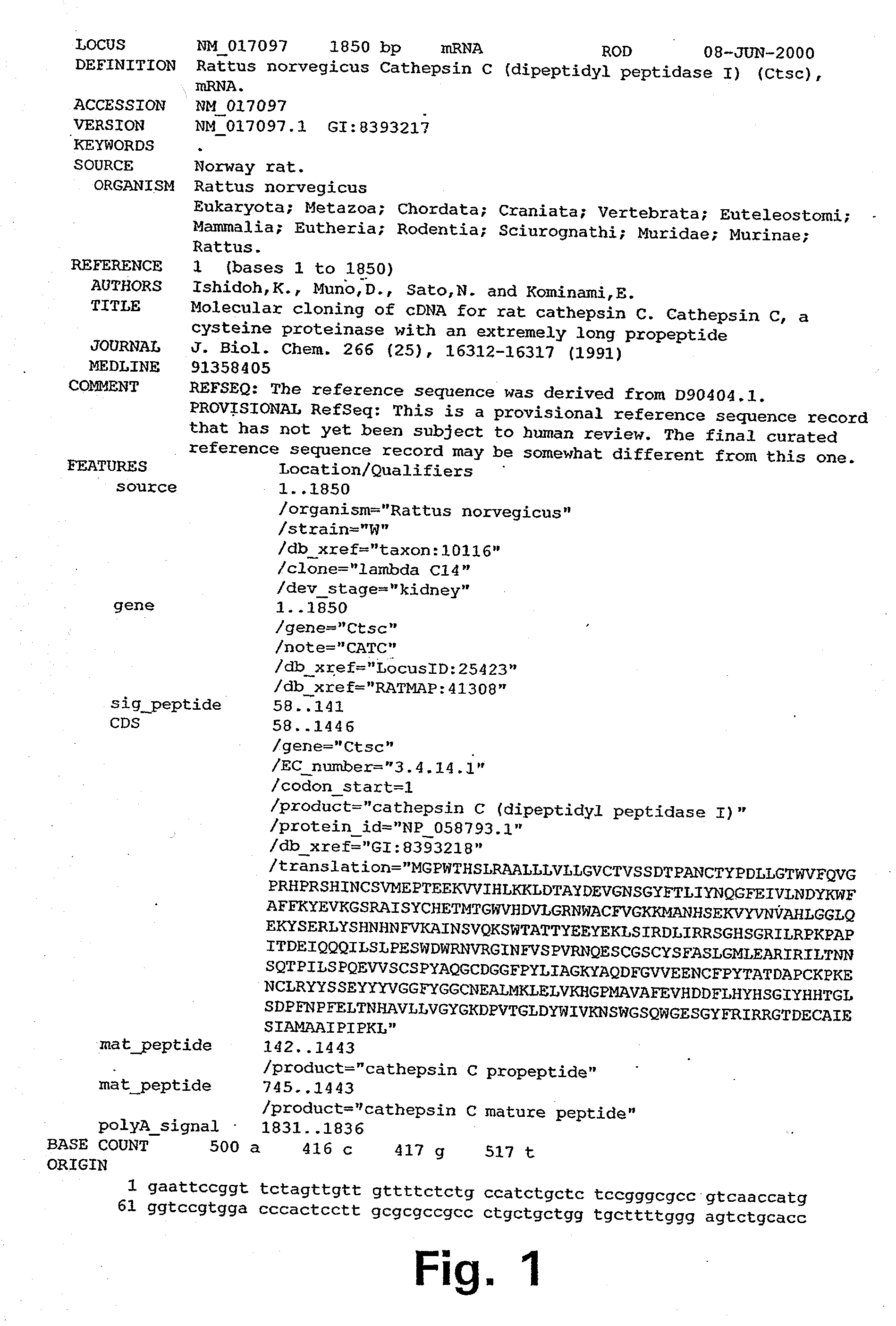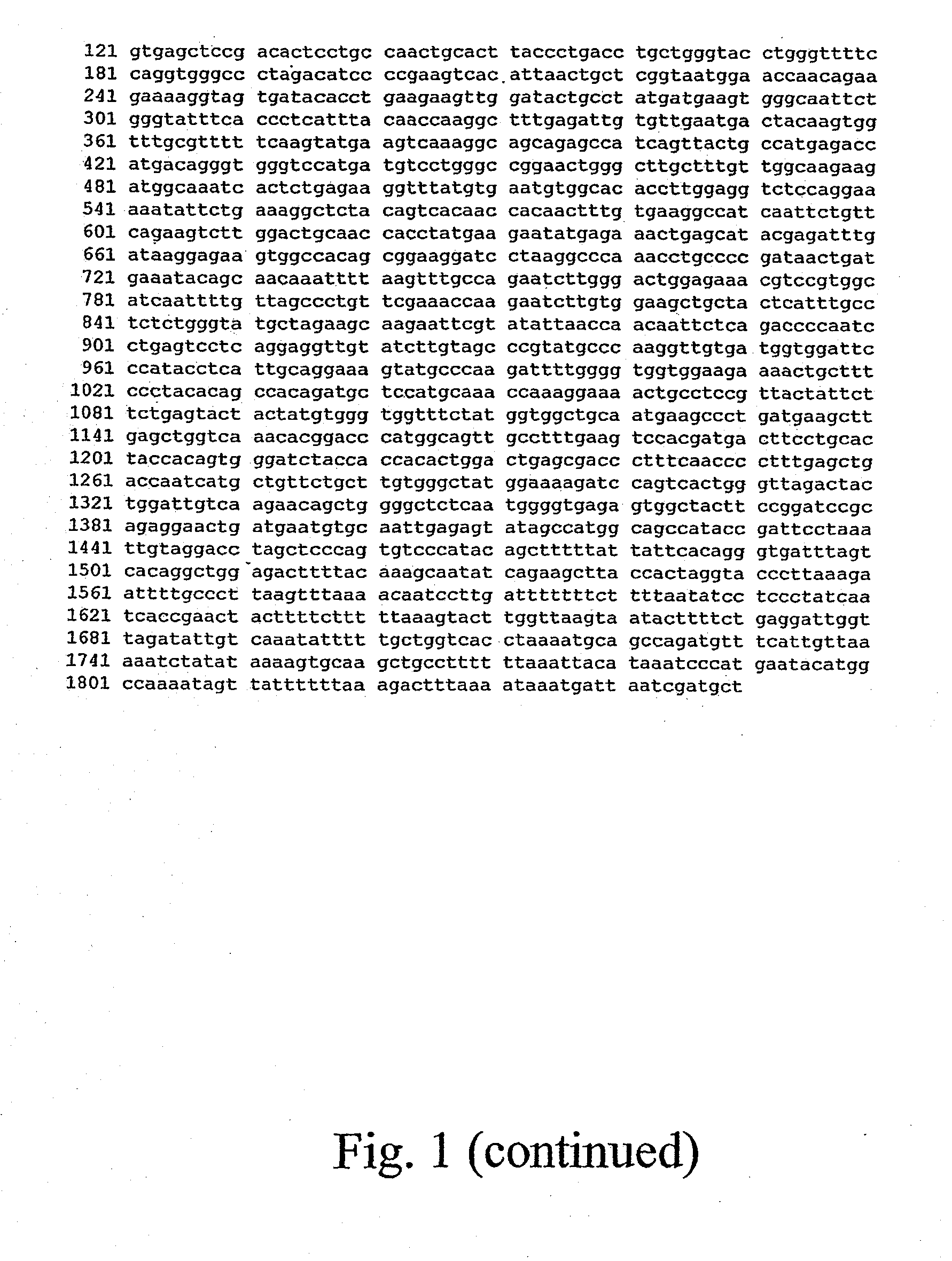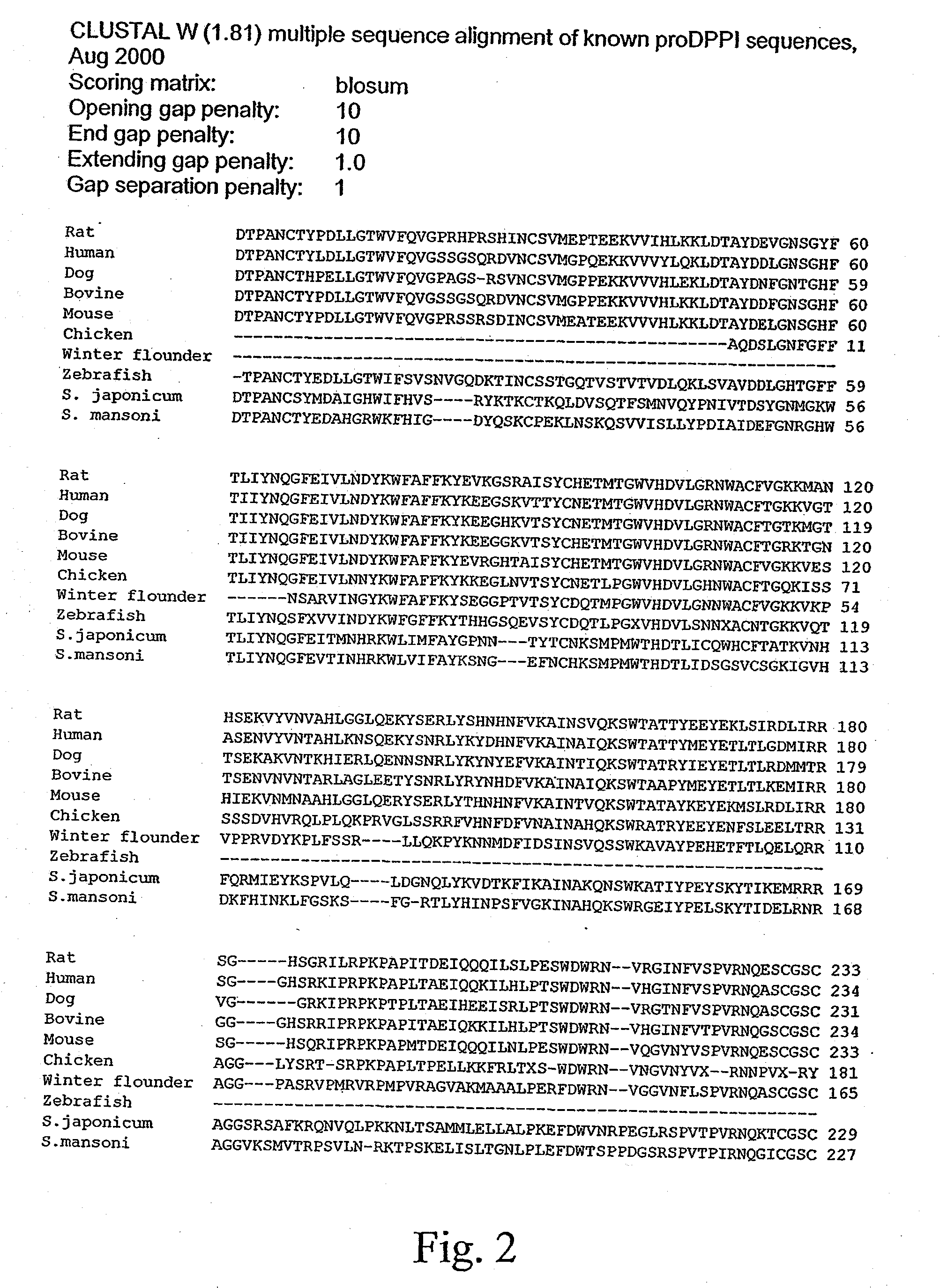Rat cathespin dipeptidyl peptidase i (DPPI): crystal structure and its uses
a dipeptide and peptide technology, applied in the field of structural studies of dipeptidyl peptidase i (dppi) proteins, can solve the problems of difficult design of inhibitors that are at the same time sufficiently selective, severe and permanent tissue damage, and difficult to achieve the effects of non-toxic, potent, and non-toxic, and increase the thermostability. , the effect of increasing stability
- Summary
- Abstract
- Description
- Claims
- Application Information
AI Technical Summary
Benefits of technology
Problems solved by technology
Method used
Image
Examples
example 1
Construction of Transfer Vector for Rat Prepro-DPPI
[0209]The construction of a baculovirus transfer vector termed pCLU10-4 (identical to the vector termed pVL 1393-DPPI) encoding rat DPPI preproenzyme is described in (Lauritzen et al. (1998) Protein Expr. Purif. 14, 434-442). Here, rat cDNA was prepared based on the sequence published by Ishidoh et al. (J. Biol. Chem. (1991) 266, 16312-16317). The rat prepro-DPPI encoding region was amplified by polymerase chain reaction (PCR) from the cDNA pool to generate restriction sites at the 5′ and 3′ ends of the portion of the sequence coding for the residues Met(−24)-Leu(438). Two oligonucleotide primers, 5′-GCT CTC CGG GCG CCG TCA ACC and 5′-GCT CTA GAT CTT ACA ATT TAG GAA TCG GTA TGG C (no. 6343 and no. 7436 from DNA Technology, Aahus, Denmark) were designed to specifically amplify the DNA sequence as well as to incorporate a HincII restriction site at the 5′ end and a BgIII restriction site and a TAA stop codon at the 3′ end of the codin...
example 2
Construction of Transfer Vector for Human Prepro-DPPI
[0211]A transfer vector termed pCLU70-1 encoding human DPPI proenzyme N-terminally fused to the signal sequence (pre-sequence) of rat DPPI preproenzyme was prepared as follows. The human pro-DPPI cDNA, previously described as a 1.9 kb full length prepro-hDPPI construct in pGEM-11Zf(−) (Paris et al. (1995) FEBS Lett. 369, 326-330) was amplified by polymerase chain reaction (PCR) to generate restriction sites at the 5′ and 3′ ends, respectively, of the portion of the hDPPI sequence coding for pro-DPPI residues-2-439 lacking all but the two N-terminal residues of the endogenous signal peptide and starting with Ser(−2) and ending with Leu(439). Two oligonucleotide primers, 5′-AAA CTG TGA GCT CCG ACA CAC CTG CCA ACT GCA-3′ (NT-HSCATC from TAGCopenhagen, Copenhagen, Denmark) and 5′-ACT GAT GCA GAT CTT TAT GAA ATA CTG GAA GGC-3′ (HS-RBGL from Gibco® BRL, LIFE TECHNOLOGIES®, Gaithersburg, Md.), were designed to specifically amplify the DN...
example 3
Preparation of Recombinant Baculoviruses
[0214]For the preparation of recombinant baculoviral stocks, pCLU10-4 and pCLU70-1 were transformed into E. coli strain TOP10 (Catalogue #C4040-10, INVITROGEN®, Groningen, The Netherlands), amplified and purified by well-established methods (WIZARD® Plus SV Minipreps DNA Purification Systems, PROMEGA®, Madison, Wis.). The purified transfer vectors pCLU10-4 and pCLU70-1 were co-transfected with BaculoGold™ DNA (Catalogue #21100D, Pharmigen, San Diego, Calif.) into Spodoptera frugiperda Sf9 cells (American Type Culture Collection, Rockville, Md.) using the calcium phosphate protocol (Gruenwald et al. (1993) Procedures and Methods Manual, 2nd ed., Pharmigen, San Diego, Calif. p. 44-49). BaculoGold™ is a modified baculovirus DNA which contains a lethal deletion and accordingly cannot encode for a viable virus by itself. When co-transfected with a complementing transfer plasmid, such as pCLU10-4 or pCLU70-1, carrying the essential gene lacking in B...
PUM
| Property | Measurement | Unit |
|---|---|---|
| pH | aaaaa | aaaaa |
| pH | aaaaa | aaaaa |
| pH | aaaaa | aaaaa |
Abstract
Description
Claims
Application Information
 Login to View More
Login to View More - R&D
- Intellectual Property
- Life Sciences
- Materials
- Tech Scout
- Unparalleled Data Quality
- Higher Quality Content
- 60% Fewer Hallucinations
Browse by: Latest US Patents, China's latest patents, Technical Efficacy Thesaurus, Application Domain, Technology Topic, Popular Technical Reports.
© 2025 PatSnap. All rights reserved.Legal|Privacy policy|Modern Slavery Act Transparency Statement|Sitemap|About US| Contact US: help@patsnap.com



